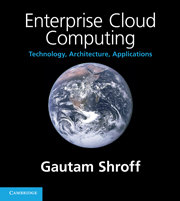Book contents
- Frontmatter
- Contents
- Preface
- List of abbreviations
- Part I Computing platforms
- Part II Cloud platforms
- Part III Cloud technologies
- Part IV Cloud development
- Part V Software architecture
- Chapter 13 Enterprise software: ERP, SCM, CRM
- Chapter 14 Custom enterprise applications and Dev 2.0
- Chapter 15 Workflow and business processes
- Chapter 16 Enterprise analytics and search
- Part VI Enterprise cloud computing
- References
- Index
Chapter 14 - Custom enterprise applications and Dev 2.0
Published online by Cambridge University Press: 06 December 2010
- Frontmatter
- Contents
- Preface
- List of abbreviations
- Part I Computing platforms
- Part II Cloud platforms
- Part III Cloud technologies
- Part IV Cloud development
- Part V Software architecture
- Chapter 13 Enterprise software: ERP, SCM, CRM
- Chapter 14 Custom enterprise applications and Dev 2.0
- Chapter 15 Workflow and business processes
- Chapter 16 Enterprise analytics and search
- Part VI Enterprise cloud computing
- References
- Index
Summary
In the previous chapter we examined the myriad information needs of a typical enterprise. We saw that at a high level these needs can be distributed across CRM, SCM or core ERP systems, which can be implemented as enterprise systems using packaged products or SaaS offerings. At the same time certain horizontal business processes, or domain-specific functionality may necessitate custom application development.
In this chapter we shall explore how such enterprise systems are built, whether as part of a packaged product or a custom-built application. In the process we shall examine the technical architecture layers, abstractions and principles required to build modern scalable enterprise applications.
In Chapter 12 we described the emerging Dev 2.0 paradigm that enables application development to be done largely without custom programming. Our discussion of technical architecture principles, common practices and abstractions will also enable us to understand how Dev 2.0 platforms are internally architected.
SOFTWARE ARCHITECTURE FOR ENTERPRISE COMPONENTS
As we saw in Figure 4.1 of Chapter 4, enterprise applications can be viewed as consisting of application components, each of which is responsible for a collection of enterprise sub-processes that all access a cohesive set of data items, such as a ‘partner,’ or ‘order’ model as covered in the previous chapter.
At the technical level each application component can be viewed as an independent application, or a part (‘module’) of a larger enterprise application, such as a CRM package.
- Type
- Chapter
- Information
- Enterprise Cloud ComputingTechnology, Architecture, Applications, pp. 178 - 202Publisher: Cambridge University PressPrint publication year: 2010



